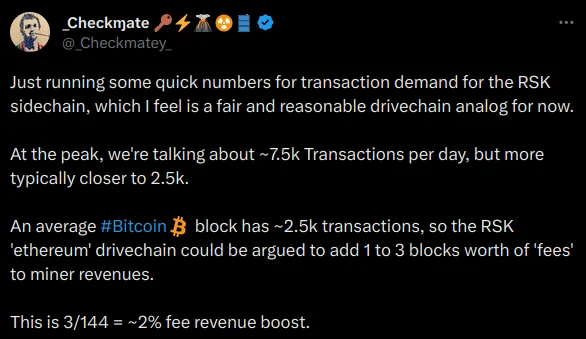Bitcoin Twitter, a sub-set of Crypto Twitter focused on discussing, debating, and fighting about Bitcoin, has recently revived a controversial discussion around Bitcoin sidechains. Initially proposed by Paul Sztorc through BIP 300 and 301 around 2017, Bitcoin Drivechains would create native sidechain capabilities directly on Bitcoin. Unsurprisingly, as this change is a soft fork of Bitcoin and introduces the potential for ‘shitcoins‘ and unknowns into the system, the community is hotly debating whether or not to adopt this upgrade. Some see it as an attack on the core protocol, and others as a natural evolution for Bitcoin.

The Bitcoin Drivechain proposal consists of two separate ones:
- BIP 300, Hashrate Escrow: Container UTXOs that compress 3-6 months of TX data into 32 bytes.
- BIP 301, Blind Merged Mining: Replaces running a sidechain node with a single high-fee transaction.
Put together, these two proposals would allow developers to deploy native L2s directly on Bitcoin. Unlike other Bitcoin L2 projects, like Stacks, RSK, or Liquid, Drivechains would offer users a more secure experience. The security guarantees would arguably be better because miners would secure the sidechains deployed through BIP 300 and 301 and not require users to ‘bridge’ BTC off Bitcoin to a federated L2. For those with experience using Ethereum, Bitcoin Drivechains are similar to L2 solutions like Optimism and Arbitrum, whereas chains like Stacks and RSK are more akin to Polygon.
Drivechains would allow developers to create specialized L2s secured by Bitcoin for experimentation, scaling, or extending Bitcoin functionality. There could be an L2 for privacy, another for smart contracts, and so on. To send funds to a sidechain, users simply send their BTC to a special address, which credits their account on the sidechain. Unfortunately, withdrawals back to the main Bitcoin chain take 3-6 months as miners slowly validate the withdrawal transactions. But, like Ethereum-based projects, I am sure that specialized fast bridges would emerge to assist users in moving funds quickly.
Of course, these proposals are controversial. Bitcoiners are notoriously resistant to changes in the protocol. But one of the reasons I find this change so interesting is that, like other L2 solutions, they are fully opt-in. If deployed, users could continue to use Bitcoin however they like and never touch a Drivechain. The function of the Drivechains doesn’t affect the core protocol at all. Additionally, I am generally in favor of anything that helps drive additional fees to Bitcoin – and creating an ecosystem of sidechains that all pay fees to miners is probably a good move for Bitcoin. But, not everyone agrees that the fee benefits would be worth the risk.

2023 is shaping up to become a big year for Bitcoin. Inscriptions reignited interest in using Bitcoin for more than hodling. People leveraged the tech to create a token ecosystem, inscribe data directly on Bitcoin, and spur meaningful conversations around Bitcoin development. We will remember 2023 as the year when Bitcoin started to shift to a culture of innovation and the beginning of some great projects. Inscriptions showed a desire for Bitcoin-native experiences beyond just moving BTC around – and the market is responding. I am unsure if drivechains are THE solution, but the conversation around it and the initial research I did for this post shows promise – it’s time to go deeper, and I recommend people take a look.

I am not a believer in silver-bullet solutions for anything. Bitcoin faces many challenges around scaling and long-term incentives. But I don’t think any one development will solve these challenges. Bitcoin will need a web of innovations and upgrades that each chip away at these issues rather than a single solution. Ordinals, inscriptions, drivechains, Lightning, and Stacks are all developments that chip away at Bitcoin’s challenges.
Unfortunately, sometimes, the conversation around these technologies for Bitcoin is hampered by the belief that unless the innovation can solve all the issues at once, then it’s not worth the risk. However, this belief seems to be changing. I have much respect for being cautious regarding upgrades to Bitcoin, but 2023 has shown that people can and want to use Bitcoin for more than hodling. As all markets do, the market is responding to this desire, and we are now seeing a new batch of scaling projects like Drivechain emerge. All of these projects will play a part in addressing Bitcoin’s shortcomings, and I couldn’t be more excited to see what people come up with.